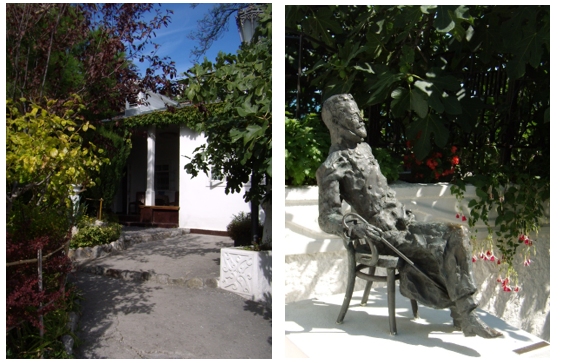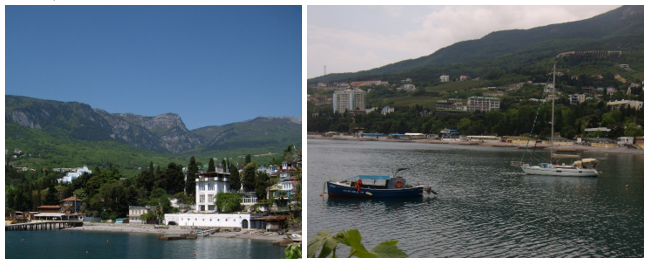Introduction
The search for ways to increase the attractiveness of a tourist destination has occupied the attention of many researchers: Nikiforova A.A. [1, 2], Koroleva I.S., Glumova Ya.G. [3], V. N. Tarasenko, S. S. Dymova [4], Stelzer M.S. [5] Dzhandzhugazova E.A. [6]. Most of them agree on the complex influence of a combination of external and internal factors on the attractiveness of the destination. What impact does the ecotope (environmental factors) of the museum have on it? We will try to find the answer to this question.
Objects and methods of research
The object of the study is the tourist destination of the department «The Dacha of A.P. Chekhov and O.L. Knipper in Gurzuf» of the SBIC of the Republic of the Crimea «Crimean Literary and Artistic Memorial Museum-Reserve» (hereinafter — the Dacha). Subjects of the study are elements of the Dacha ecotope involved in the formation of visitor satisfaction. To achieve the purpose of the study, we will determine the factors of the natural environment that take part in the formation of the tourist destination of the museum, determine the degree of their attractiveness. We will use PEST-analysis and general scientific methods of analysis, analogy and synthesis to solve the tasks set.
Experimental part
The names of A.P. Chekhov and his wife O.L. Knipper are the key attractive factor of the tourist destination of the Dacha. The famous play «Three Sisters», on which the writer worked here, the names of famous guests of the dacha owners also attract visitors. The mystery that invariably attracts fans of the writer to the museum remains A.P. Chekhov’s choice of a place for a dacha in Gurzuf – why did the writer decide to settle here.
Visitors answer this question differently for themselves. Let us perform a PEST analysis of their reviews from the «Book of reviews and suggestions for 2022». The results we present with a table, ranking by the frequency of occurrence of relevant opinions (see Table 1).
Table 1
| Reviews | Quantity of reviews | % | Rank |
| All Reviews | 710 | 100 | |
| Reviews about ecotope | 156 | 21,9 | |
| Location/Landscape | 98 | 13,8 | 1 |
| Landscapes/views | 20 | 3,8 | 2 |
| Sea | 7 | 1 | 3 |
| Garden | 7 | 1 | 3 |
| Bay | 6 | 0,8 | 4 |
| Rocks | 5 | 0,7 | 5 |
| Coast | 4 | 0,6 | 6 |
| Vegetation, surf | 2 | 0,3 | 7 |
| Other reviews | 554 | 78,1 |
Thus, about 22% of visitors who left their feedback about the Dacha in 2022 found the answer to this question in the natural environment surrounding the Dacha – in other words, in its ecotope.
13.8% of visitors considered the location of the Dacha significant – 1st place in the rating. The saklya is located on the base of a rocky promontory on the southern slope of the main ridge of the Crimean Mountains. Black Sea surround it on the both sides and separate it from the Genoese rock with a small bay – «Chekhov’s bay». There are a saklya building, a small courtyard with a garden and a beach. The climate is dry subtropical Mediterranean.

Photo 1 (made by authors) Photo 2 (made by authors)
Landscapes/views – 3.8% – took 2nd place in the rating. From the territory of the Dacha there are a panoramic views of the Black Sea with the Adalar rocks, the Genoese Rock and the Gurzuf Bay with the picturesque southern slopes of Nikita’s Yayla, the main ridge of the Crimean Mountains on the shore, covered with mixed forest and areas of settlement urban development.

Photo 3 (made by authors) Photo 4 (made by authors)
Sea and garden – 3rd place in the rating of reviews. Panoramic sea views are combined with the presence of a rich variety of marine flora and fauna: algae, cormorants (Phalacrocorax carbo, Microcarbo pygmaeus), ducks, mullet (Mugil cephalus), horse mackerel (Trachurus mediterraneus), gobies, wrasses, stone crabs (Eriphia verrucosa), dolphins (Delphinus delphis and Tursiops truncatus), etc. Part of the plants from A.P. Chekhov’s Yalta collection and succulents is presented in the garden of the dacha [7]. The animal world of the garden includes yellowbellies (Pseudopus apodus), Mediterranean geckos (Mediodactylus kotschyi), Crimean scorpions (Euscorpius tauricus), stone martens (Martes foina), etc.

Photo 5 (made by authors) Photo 6 (made by authors)
Conclusions
Thus, based on the above, we may conclude:
- ecotope is an integral component of the museum’s tourist destination;
- ecotope and its elements arouse interest and give satisfaction to about 22% of visitors to the Dacha;
- there is possibility to use the ecotope and its elements in order to increase the attractiveness of the tourist destination of the museum.
Rational use of the Dacha ecotope in all types of museum activities requires further study, development and, of course, protection and preservation of its biological diversity.
References
1. Никифорова, А. А. Музеи в туристском пространстве регионов / А. А. Никифорова // ЦИТИСЭ. – 2022. – № 2(32). – С. 367-373.2. Никифорова, А. А. Роль туристского легендирования в развитии территории / А. А. Никифорова // Lingua-Universum. – 2022. – № 2. – С. 58-60.
3. Королева, И. С. Музейная дестинация как элемент региональной туристско-рекреационной системы / И. С. Королева, Я. Г. Глумова // Фундаментальные исследования. – 2018. – № 4. – С. 87-91.
4. Тарасенко, В. Н. Управление культурой: туризм как фактор сохранения культурного наследия / В. Н. Тарасенко, С. С. Дымова // Бизнес и дизайн ревю. – 2021. – № 2(22).
5. Штельцер, М. С. Туристские дестинации и музей - в поисках оснований / М. С. Штельцер // Экономические исследования и разработки. – 2022. – № 10. – С. 64-69.
6. Джанджугазова, Е. А. Туристская привлекательность ландшафта: особенности восприятия (на примере музея-заповедника «Кижи») / Е. А. Джанджугазова // Российские регионы: взгляд в будущее. – 2018. – Т. 5, № 3. – С. 42-53.
7. Долгополова, Ю. Г. Необыкновенный сад А. П. Чехова. История создания / Ю. Г. Долгополова // Необыкновенный сад А.П. Чехова : альбом-каталог. Том 1. – Ялта : Государственное бюджетное учреждение культуры Республики Крым «Крымский литературно-художественный мемориальный музей-заповедник», 2018. – С. 6-22.
